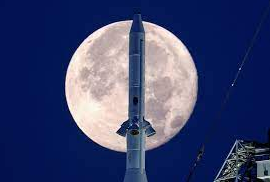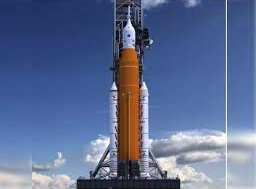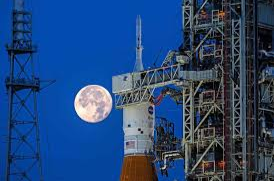Returning to the Earth’s Satellite: Artemis I Mission

January 11, 2023
On November 16, 2022, at 1:47 PM, NASA launched a program in which the goal would be something that was already completed nearly fifty years ago: they sent a rocket to the moon. Almost one half-century ago, the Apollo mission concluded with a small group of astronauts splashing down into the Atlantic ocean.
Returning to the Lunar Surface
July 20, 1969, was when the first steps on the moon were taken by Neil Armstrong and Buzz Aldrin. But once the Apollo mission was complete, NASA wanted to focus on creating and maintaining space stations that would be launched into Earth’s orbit. Since then, NASA has launched a few stations: a temporary one called Skylab and another, more famous global space station: the ISS (International Space Station). Although some U.S. leaders have wanted NASA to shift their focus from Earth’s  to more distant outer space, it has not entirely succeeded – until now.
to more distant outer space, it has not entirely succeeded – until now.
The Artemis project is a “Moon to Mars” action: where humans are pushing their frontiers further from Earth. First, the project would like the next man and first woman on the moon to be part of their own: landing more people on Earth’s only satellite. Secondly, after a few years of lunar experiments and training, NASA wants to send astronauts to the Red Planet.
According to a planetary geologist, Jacob Bleacher, “The goal with Artemis is to build off everything we’ve done to this point and really start to establish a presence for humanity beyond low Earth orbit.” Mainly, he states that Artemis is going to launch people beyond the orbit of the Earth, beyond the moon and to our neighbor planet in the solar system.
After working for over a decade, NASA produced a rocket called the Space Launch System (SLS) as the first big step within the Moon to Mars project. Artemis l has had a bit of a rough start with impact from a few hurricanes in addition to fuel leaks.
Luckily, Artemis l is off the ground now. It’s testing a mission, roughly a month long, beyond the moon and back. The SLS is undertaking the mission along with the (currently empty) Orion crew capsule: a chamber that holds four astronauts. Similarly, the Artemis ll mission will be flying along a similar course as the Artemis l, but this time, it will have astronauts within it. The Artemis lll project is scheduled to launch in 2025, with its main goal being to land the first woman on the moon.
On that same flight, the SLS will launch the (then occupied) Orion capsule at the moon. When the capsule lands in lunar orbit, it will join with the human landing system, developed by SpaceX. Additionally, SpaceX will take two astronauts to the lunar surface for a 6.5 day ‘vacation’.
NASA is also creating another space station called the Gateway. The Gateway would orbit the moon once its production is completed. It will serve as a research station for both international and commercial purposes, and will serve as a way station for going to Mars and possibly even further into the solar system.
The main goal of the program is to increase the length of the stay on the moon, from days to hopefully even months within the coming years. Then, there would be the development of hardware and electricity on the moon and rovers. Finally, NASA is hoping to have living and working quarters on the lunar surface!
Better Than Rovers
The Apollo mission was centered around political means: the Space Race between the U.S. and the Soviet Union, both nations working hard to land their citizens on the lunar surface first. After Neil Armstrong and Buzz Aldrin landed on the moon, a little under a dozen more American astronauts walked on the moon. However, the final Apollo mission concluded with Apollo XVll (17). After Eugene Cernan and Harrison H. Schmitt left their footprints on the moon, no humans walked the lunar surface ever again.
Instead, rovers have travelled to and from the moon with ease. Rovers are automated robots that do the (occasionally) dangerous work of astronauts with expendable mach inery. Various countries have sent their spacecraft to the moon: sometimes to orbit, other times to collect lunar samples and return them to Earth. A few missions were launched to smash into the lunar surface to collect data from the debris!
inery. Various countries have sent their spacecraft to the moon: sometimes to orbit, other times to collect lunar samples and return them to Earth. A few missions were launched to smash into the lunar surface to collect data from the debris!
Although the rovers are incredibly useful, the robots don’t even measure up to the huge steps that humans could take. “Nothing can replace the value of having a human brain and human eyes there on the scene,” states Jose Hurtado, a geologist from a NASA affiliate at the University of Texas.
The Apollo 17 mission proves how valuable humans are on the lunar surface. When Schmitt, the only geologist to ever visit the moon, landed on the surface, he noted a rusty hue on the ground. He took in his surroundings and realized that it was evidence of a volcanic eruption. After taking samples and testing them in laboratories back on Earth, it revealed that 3.7 billion years ago, there was a “fire fountain” explosion.
After more analysis of the orange-hued lunar soil, it hinted that the moon had more volcanic activity in its youth. Moreover, data showed that the moon formed at approximately the same time as Earth: an incredible discovery in the world of astronomy.
Compared to the data that rovers have collected, the Artemis missions are nearly guaranteed to make more great discoveries on the lunar surface.
A New-age Space Collaboration
While NASA is making great strides in exploring our universe more, the U.S. is not the only country to be doing so. China is also aiming to land its own astronauts at the South Pole of the moon within the next decade. Beginning in 2004, China launched its own lunar exploration program named Chang’e. Chang’e, named after the Chinese goddess of the moon, has also seen some advanced progress.
In 2018, China put a communication satellite in lunar orbit, and in 2019, they landed a rover on the hidden dark side of the moon. The still-operating rover was joined by another rover in 2020, which brought back soil samples from the viewed part (the nearside) of Earth’s natural satellite. Chang’e 6, which hasn’t launched yet, is slated to collect material from the dark side of the moon, and Chang’e 7 wants to search for water on the moon – in the form of ice. China also has a space station in orbit, and is also looking to reach the Red Planet. They landed a Mars rover in 2021.
Unfortunately, although NASA may want to jointly work on a project with China, they cannot. Space exploration and actions are important and relevant for both nations, especially as they have similar goals. However, they can’t collaborate due to the Wolf Amendment: NASA cannot collaborate on projects unless permission is granted from the U.S. Congress.
But on the flip side, some astronauts and scientists working on the lunar projects hope for collaboration in other ways. They believe that the U.S. and Chin a can share samples, and work to help one another along. According to James Head, a geologist from Brown University states, “There are a lot of different places in space, and there’s no sense in duplicating everything.”
a can share samples, and work to help one another along. According to James Head, a geologist from Brown University states, “There are a lot of different places in space, and there’s no sense in duplicating everything.”
Both the Artemis project and the Moon to Mars project would benefit from a collaboration with China: more samples leads to more data, and more data leads to more discoveries. The more discoveries made for the lunar and Mars project would benefit it in whichever way that it can, and have an impact on the future of space exploration.
The Bottom of the Moon
The next time that humans land on the moon through the Artemis project would be to a never-before-explored place: the South Pole. Impact craters and ancient, uplifted materials are common there: perfect for gathering data and reaching important conclusions. And a resource that’s as valuable as gold on the moon: water ice. Both the U.S. and China are going to look at this area to support their resources that they would need for an extended stay on the lunar surface.
The moon’s rocky surface at the South Pole would have ancient materials within its soil. Materials, such as those that zoomed through the universe within the first billion years of the universe’s history. Materials, such as those that slammed into newly minted and very active young planets.
Earth can’t explain that history to humans, with the rise of human settlements (and the fact that Earth has liquid water). However, the moon, without liquid water and no civilizations, can. The Artemis mission will be able to explore the surface of the moon: a very detailed record of meteorite impacts in the past billions of years.
Even though those records are important mysteries, the deposits of frozen water in the deep craters of the moon are even more thrilling to explore. How much ice is there? Can samples be taken? Can humans utilize it in the colonization of the moon? Those are questions that the Artemis mission is intent on answering, which would even enable longer lapses of exploration and stays on the lunar surface.
The Artemis mission is set on solving many mysteries and achieving many goals. Having a lasting presence on a celestial body other than Earth is an incredibly important milestone for humans, one that they hope to achieve on the moon. But for now, just look to the skies in the middle of the night, and know that incredible things are happening on that bright, celestial whitish-yellow orb.
Kruesi, Liz. “Artemis I Finally Launched. Here’s What It Means for Human Spaceflight.” Science News, 16 Nov. 2022, www.sciencenews.org/article/moon-artemis-launch-human-spaceflight-apollo-nasa-china.
Tingley, Brett. “NASA ‘giddy’ Over Amazing Moon Views From Artemis 1 Orion Spacecraft.” Space.com, 22 Nov. 2022,
“Artemis I Preparing for Launch.” People.
“Artemis I Rocket With Moon Background.” ABC.
“Artemis Rocket.” News 9 Live.




